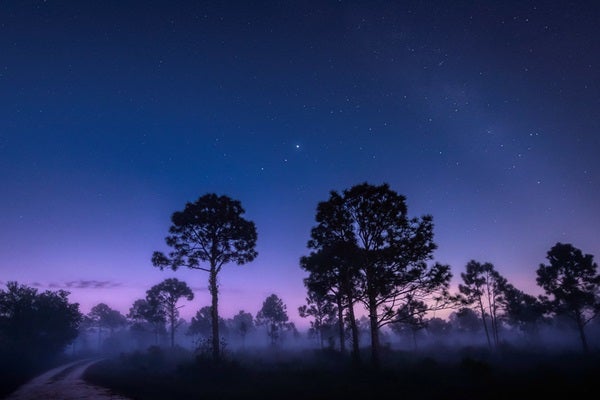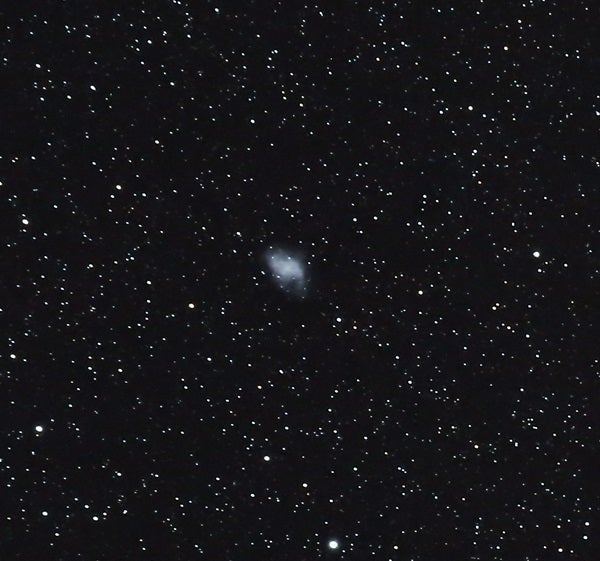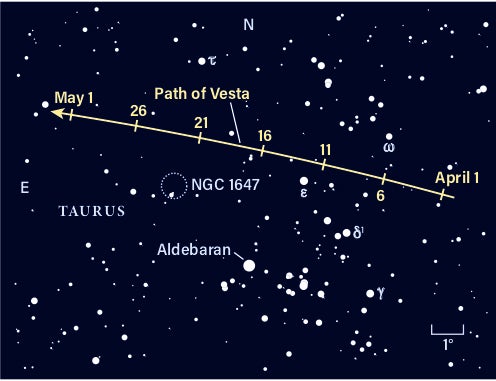If you were captivated by the recent news of a planet disappearing right before astronomers’ eyes, you may want to take up the challenge of spotting the star where this event happened. Now visible just before sunrise, Fomalhaut is a magnitude 1 star in the constellation Piscis Austrinus. Its time in the Northern Hemisphere sky is quickly coming to an end as the winter constellations give way to summer ones. Midwestern observers with a clear view of the southeastern sky can catch Fomalhaut just scraping the horizon half an hour before sunrise, slowly climbing higher. Those in states farther south will see the star slightly higher and should have a better chance of spotting it. You may need binoculars or a small telescope to glimpse the star against the brightening sky. If you can’t find it, don’t worry. By September the star will reappear, rising in the evening and skimming through the skies all night.
Today marks the 30th anniversary of the deployment of the Hubble Space Telescope. This groundbreaking observatory has played a crucial part in numerous discoveries in the decades since its first images, and remains one of astronomers’ best tools today.
According to James Fanson, project manager of the Giant Magellan Telescope currently under construction in Chile, “The Hubble Space Telescope revolutionized astronomy in the same way Galileo’s telescope did 400 years ago when first turned to the heavens. Hubble’s images reached the level of art, and its discoveries touched the imagination of ordinary people around the world. Hubble became the ‘people’s telescope,’ and it will always have a cherished place in our history and culture.”
You can celebrate Hubble’s success by challenging yourself to find one of its frequent targets: M1, also known as NGC 1952 or the Crab Nebula. This famous supernova remnant resulted from the death of a massive star; Chinese astronomers recorded the event in the year A.D. 1054, when a “guest star” briefly appeared in the nighttime — and daytime — sky. All that remains of the luminary is a tiny pulsar (a spinning neutron star) surrounded by what was once the atmosphere and interior of the star itself, now a tangled, glowing nebula.
Although the Moon is nearby, it’s a mere 7 percent lit, so a larger scope should still reveal the Crab’s faint, nebulous glow. Unlike the highly detailed Hubble images, M1 appears only as a small thumbprint of light through an amateur scope, but it’s still a tantalizing target to search out for yourself. Tonight, the Crab sits a little less than 10° southeast of Venus, which provides an easy signpost on your way to finding the faint object.
Sunday, April 26
Uranus is in conjunction with the Sun at 5 A.M. EDT. Pluto is stationary at 9 A.M. EDT, ending its eastern trek across the sky. It will now begin tracking slowly to the southwest, back toward the center of the constellation Sagittarius.
The Moon passes 0.1° north of asteroid Vesta at 7 A.M. EDT; our satellite then passes 6° south of Venus at 11 A.M. EDT. By this evening, Venus is 7° to the right of the waxing crescent Moon. The pair is already shining in the eastern region of Taurus the Bull as darkness falls, with the V-shaped Hyades star cluster hanging below them. To the southeast lies Orion the Hunter, tilting low toward the western horizon as he and other favorite winter sky constellations finally begin to disappear from nighttime view.
Monday, April 27
Venus reaches greatest brilliancy at 2 P.M. EDT today, when it glows at magnitude –4.7. The planet is still 25° above the western horizon an hour after sunset and is now about 17° west of the Moon. Venus has slimmed down from a 46-percent-illuminated crescent at the start of the month to just 28 percent lit tonight. The planet’s apparent size has grown from 26″ to 37″ in the same timeframe.
Slide your eyes, binoculars, or scope an additional 18° west from Venus to take in the sparkling Pleiades (M45); Venus visited this dipper-shaped young cluster of stars earlier in the month.
At magnitude 8.4, Vesta is within easy reach of most binoculars. To find it, locate Aldebaran, the brightest star in Taurus, and draw an imaginary line northeast. First, you’ll hit the open star cluster NGC 1647, which contains several dozen scattered 8th- to 11th- magnitude stars. Continue that line roughly the same distance to the northeast and begin scanning for Vesta, which is slowly advancing through a region with few background stars. Try this exercise two or three nights in a row to find the spot that has moved — that’s the asteroid you’re looking for.
Wednesday, April 29
Mars remains an ideal morning target to catch before sunrise. The Red Planet glows at magnitude 0.4 in the southeastern sky, positioned midway between two 4th-magnitude stars: Iota (ι) and Gamma (γ) Capricorni. Mars is nearly 20° above the horizon an hour before sunrise.
Mars also stands at the center of a planetary gathering. Look west to find Saturn nearly 19° away, with Jupiter just 5° farther in the same direction. These two solar system giants shine at magnitude 0.6 and –2.4, respectively. Telescopic observers and imagers can add a dwarf planet to the mix: Pluto is just 2° southwest of Jupiter, glinting faintly at magnitude 14.
Turn your telescope 30° east of Mars to glimpse magnitude 8 Neptune. The ice giant is still low on the eastern horizon, rising higher as the sky brightens with the coming dawn. See how long you can track it before the bright sky hides it from view.
Thursday, April 30
First Quarter Moon occurs at 4:38 P.M. EDT. An hour after sunset, our satellite stands high in the southwestern sky in the faint constellation Cancer the Crab. In the moonlit sky, you might have better luck spotting Gemini the Twins and their bright luminaries, Castor and Pollux, to the west. Look east of the Moon to find Leo the Lion, with his brightest star Regulus, and follow the ecliptic farther east to reach Virgo the Maiden, whose brightest star is Spica. This blue-white magnitude 1 star is not one star, but two — however, the stars are so close that they cannot be split visually. Instead, astronomers discovered Spica’s dual nature by noticing that as one star orbits the other, gravity’s effects shift the light we see from the star slightly red and then blue over time.
The larger of the two, Spica A, is roughly seven times wider than our Sun and 10 times as massive. Most of the light we see from the “star” comes from this component. The smaller Spica B is a little less than four times wider than the Sun and seven times as massive.
Friday, May 1
The Eta Aquariids have been slowly ramping up since last week and will peak in another few days. It’s not one of the year’s best meteor showers, due to its low-altitude radiant in the Northern Hemisphere and low predicted rate of just 10 meteors per hour at its peak. But with Mars hanging nearby and a still-crescent Moon in the sky, it’s worth trying to catch a few shooting stars this morning.
Find the darkest skies possible and spend some time scanning overhead. Try concentrating on a spot away from the constellation Aquarius, where the shower’s meteors originate. You may only see five or so Eta Aquariid meteors an hour, but this is also a great chance to relax beneath the stars and get to know the morning sky much better.

Our exclusive Sky Guide 2020 is now available! This free downloadable pamphlet contains a month-by-month rundown of 2020’s biggest celestial events, from Mars’ best opposition in years to the return of totality in South America this December. Check out Astronomy’s Sky Guide 2020 now!












